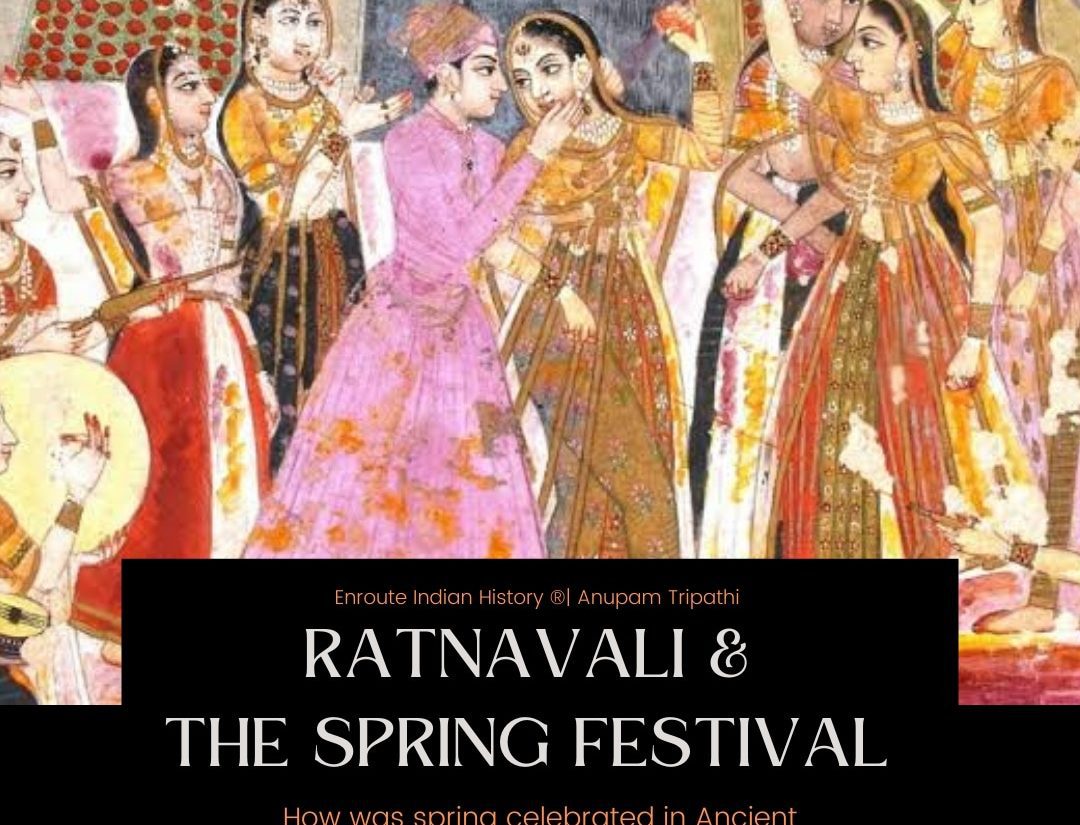
Article by EIH Researcher and Writer
Anupam Tripathi
The spring season is known as nature’s youth as the weather oscillates between cold winters and hot summers. It is the time of rebirth, rejuvenation and new beginnings. The Indian calendar is marked by a number of festivals. Among these festivals is the Vasantotsava, celebrated in spring. Although this festival is no longer celebrated in its original form, Vasantotsava was an important event in ancient and medieval times. This is evidenced by the extensive descriptions found in Indian literature such as Ratnavali and Vikramcharita. The period important for this festival is the end of the lunar month Phalguna (February-March) and the month of Chaitra (March-April). This is when the spring equinox occurs. This marks the beginning of spring and thus the occasion of Vasantotsava. Scholars generally agree that there can be separate components for spring festivals clustered around the spring season, such as Vasantotsava, Holika, Kamotsava, Chaitrotsava, etc.
The classic Ratnavali, written by Harsha in the 6th century CE, not only contains a detailed and vivid description of the Spring Festival, but also was written to be performed on the occasion. In its description, the Ratnavali emphasizes the boorishness that characterizes this festival and tells us about the ritual worship of Kama, the Hindu god of love. It is also a particularly important text because it gives us a relatively complete picture of this festival as it was celebrated at a specific time and place (in the seventh century in the central Indian city of Kausambi). Ratnavali gives two accounts of the festival: one focusing on the festival as it was held in the city streets and a second part focusing on the festival as it was held in the garden. In each of these environments, the Spring Festival takes on distinct characteristics: in the city, celebrations are marked by the free and sometimes wild behavior of the townsfolk, while celebrations in the garden focus on the worship of the deity Kama. Numerous texts connect the worship of Kama with spring and further identify the spring festival with the festival of Kama. Kalidas tells us in the Kumarsambhawa that spring is an aid to the effectiveness of kama. Many of the properties of Kama make its worship particularly beneficial at this time and particularly associated with this festival. The following excerpt sheds light on how Vasantotsava was celebrated as a town festival:
“Since in front rises the hum of people’s merriment sweet with music played to the accompaniment of a mellow drum, I believe that His Majesty is proceeding to the mansion to witness the rejoicing of the citizens, intense because of Madana’s festival (madanamaha) Observe the charm of this Love’s festival which interests one with the citizens who are dancing at the touch of water from syringes. Citizens are voluntarily seized by lovely women now under the exhilaration of wine. The openings of the road all round are singing with the swelling music of wild songs, and all the quarters are rendered yellowish red with a mass of fragrant powder scattered about. Participants engage in drinking, singing, and dancing as well as the ritual of powder throwing. It also gives us information regarding the ritual worship of Kama, the Hindu god of love.”
Music, singing, dancing, drinking wine, general sporting of the citizens with water-filled syringes and throwing yellowish-reddish powder are the dominant parts of the celebrations. It has often been noted that at festival times there is a general freeing of social restrictions amongst citizens. Vasantotsava is no exception: the tone of the Spring Festival, as described above, is one of unabashed joy. The whole city is full of colors, music and songs. Courtesan sport is just as prominently represented at this festival as the participation of the observer king. Ratnavali contains references to the importance of throwing substances at each other in the spring and describes the material to be released as coloured water, mud or dust. Dance is specifically mentioned in Ratnavali as a spring dance. In addition, it is performed mostly by women. It also mentions the role of songs in the Spring Festival. In parts of UP and Bihar, till today, people start singing Phagua (spring song) with the beginning of the Spring Festival. Ratnavali describes the drinking of wine at mixed gatherings of men and women on the streets, an activity sanctioned only on public holidays and particularly on Spring Festival days.
In conclusion, the Ratnaval gives us a vivid a pictue of the Vasantotsava as a popular folk festival celebrated by the citizens of the city as well as an elite festival celebrated specifically by the king, his harem, and nature.
REFERENCE:
- Ratnavali. Preface and translation by C. R. Devadhar and N.G. Suru. Poona: Poona Oriental Bookhouse, 1954.
- Leona Anderson, A Study of Indian Spring Festivals From Ancient and Medieval Sanskrit Texts.





